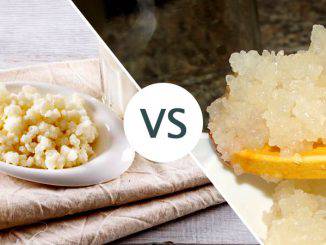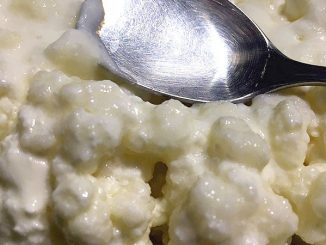
As an assumed “superfood”, Kefir is often shrouded in myths and legends, and while some of them are based on scientific facts, others are a result of ignorance and exaggeration.
This article will draw a clear line between real scientific facts and myths.
No metal should enter into contact with Kefir
Fact:
Indeed, the prolonged contact of Kefir’s acids with some metals could lead to chemical reactions that could harm the microorganisms of Kefir. That’s especially true for household utensils and cutlery made of aluminum, copper, silver, or iron. So, to handle your Kefir, you’d better not use kitchenware made of these metals.
Myth vs. Reality:
However, this does not apply to stainless steel – the metal used to make most household utensils and kitchenware. Thanks to the presence of chromium in the alloy, stainless steel is considerably less reactive to acids. Besides making it resistant to corrosion, it also makes it perfectly unreactive and safe for Kefir.
While you should still avoid using household utensils made of raw aluminum, copper, silver, or iron, stirring your Kefir with a tablespoon (usually made of stainless steel) will not harm your Kefir in any way.
Kefir grains should be rinsed at each milk change
Fact:
The slimy substance that usually surrounds the Kefir grains after you strain them out of your brew is called Kefiran. That’s a polysaccharide naturally secreted by the bacteria in kefir grains, creating for them a friendly environment. This slimy substance also acts as a sort of “antifreeze” that prevents Kefir grains from freezing if you put them in the freezer.
Kefiran is not any kind of mold, or a product of putrefactive processes, and is not harmful in any way. Quite the opposite – it is a beneficial substance creating a suitable living environment for the grains of Kefir. Kefir grains need Kefiran for their living, and when you wash it off you only force them to rebuild it.
Myth vs. Reality:
Many Kefir users find this slimy substance “disgusting” and advise rinsing the grains to get rid of this “unpleasant slimy stuff”. While rinsing Kefir grains and removing their Kefiran would do no real harm, it will only slow down the fermentation process until the Kefir grains regenerate their new layer of Kefiran.
So, if you still find Kefiran “too slimy” or “disgusting”, you may rinse your grains with non-chlorinated water without hurting them, but this will only force Kefir grains to rebuild their layer of Kefiran that would be nothing but a waste of time and energy.
The best Kefir is made with raw, unpasteurized milk
Fact:
Unpasteurized milk can be dangerous. As simple as that! It may contain extremely hazardous bacteria like Brucella, E. coli, Listeria, Salmonella, and even Bacillus anthracis, causing Anthrax. So, our clear advice is: never use unpasteurized milk or non-pre-boiled milk to make Kefir.
Myth vs. Reality:
A common myth is that “raw” milk contains more beneficial substances because pasteurization (or pre-boiling) kills most bacteria in milk. While this is true, the real benefits of fermented milk products, Kefir included, are acquired during fermentation, which happens after pasteurization.
So, any pasteurization that happens before the fermentation cannot affect in any way the probiotic powers of Kefir.
Some cheesemakers advocate using unpasteurized milk to obtain a more flavor-rich product, and sometimes they are right. However, the ferments used in cheesemaking and the long maturation periods applied in this industry make unpasteurized milk less risky. Unfortunately, this doesn’t apply to Kefir, because the relatively short fermentation time of Kefir doesn’t allow raw milk to get rid of its potentially hazardous bacteria.
Remember: the use of unpasteurized milk in Kefir making may be really hazardous.
Pasteurization or boiling of milk before fermentation cannot affect the probiotic bacteria that develop during the fermentation. On the opposite – pasteurization kills potentially harmful bacteria in milk, creating favorable conditions for the development of beneficial bacteria during the fermentation of Kefir.
No UHT milk should be used to make kefir
Fact:
Milk that has been pasteurized under Ultra-High Temperature (UHT) is the type of milk with the longest shelf life. It also contains the lowest possible levels of potentially harmful bacteria.
Myth vs. Reality:
The almost complete “sterility” of UHT milk is probably the reason why many Kefir fans suggest that it shouldn’t be used to prepare probiotic products, as it could decrease their probiotic powers. However, this allegation has no scientific justification.
The bacteria of Kefir feed on the lactose in milk, and UHT processing doesn’t affect lactose in any way. Lactose is still abundantly present in UHT milk and can still serve as a leading food for the probiotic bacteria of Kefir.
So, as long as lactose is still present in UHT milk and can feed the bacteria, Ultra-High Temperature processing of milk won’t affect the fermentation process and decrease the probiotic powers or Kefir.
Commercial Kefir products are as good as homemade ones
Fact:
Since natural, homemade Kefir keeps on fermenting even in a refrigerator, its shelf life cannot be longer than a couple of days. After that, it gets too tangy and acidic to be sold commercially.
Of course, such a short shelf life is not acceptable on a larger commercial scale. So, to extend their shelf life, most commercial producers of Kefir and its derivatives are forced to add preservatives or pasteurize their products after fermentation.
Myth vs. Reality:
Commercial Kefir products look and taste similar to homemade ones, so they should be equally good for our health, right? Wrong! They just can’t be equal.
Commercial Kefir producers can’t cope with the need for extended shelf life without the application of different methods of preservation that inevitably interfere with the probiotic properties of their products.
If you’re looking for real probiotic foods, stick to homemade ones. The urge for a decent shelf life prevents commercial products from being even close to homemade probiotic foods.
Kefir starters and kefir grains are no different
Fact:
Commercial Kefir starters (a.k.a. “kefir starter cultures”) are powdery substances composed of lyophilized or freeze-dried Kefir extracts. They should normally contain the same range of probiotic bacteria Kefir grains have, but they rarely do. Moreover, Kefir starters are intended for single use. Although most starters can be re-used a couple of times, finally, the bacteria weaken and stop fermenting milk.
Myth vs. Reality:
Kefir starters can make a kefir drink that looks, smells, and tastes like Kefir made with natural Kefir grains. However, the only advantage of Kefir starters is that they can provide consistent content and quality throughout large production batches. Additionally, the way Kefir starters are produced prevents them from containing the full range of probiotic bacteria that healthy Kefir grains can provide. Moreover, as we already said, Kefir starters are intended for single use only.
If you choose, always prefer making your Kefir with healthy Kefir grains instead of starters. If regularly fed, Kefir grains may last forever and provide a more healthful and probiotic-rich product.
In a separate post on our website, you can find more information about the difference between Kefir grains and Kefir starters, and their pros and cons.
You can either get Kefir grains from another Kefir user or purchase them from Amazon together with comprehensive tutorials.
While, as we said, Kefir starters are intended for a single-use, they are much easier to handle and provide constant quality and taste. You can purchase high-quality Kefir starters by clicking here or here.
Kefir can cure diseases and can replace drugs
Fact:
Kefir is undoubtedly a potent probiotic drink that has a myriad of positive effects on human health. Kefir can be a valuable dietetic addition to the treatment of severe diseases like colitis, ulcers, diabetes, and even cancer. Kefir has proven positive effects in controlling cholesterol, decreasing blood pressure and blood sugar levels, and preventing heart attacks and strokes.
However, Kefir is just a food, not a medication. Kefir can support but cannot replace medications.
Myth vs. Reality:
The benefits of Kefir for our health and well-being are undeniable but often exaggerated and shrouded in myths and legends.
While the anti-carcinogenic effects of Kefir are well studied and proven, we should not expect to fight cancer by just drinking Kefir. While the positive effects of Kefir in preventing heart attacks and decreasing blood pressure are undeniable, if you have a heart attack, please call 911. At this stage, drinking Kefir won’t help.
Briefly, Kefir is undeniably a valuable addition to almost any medical treatment, but it will never replace it.



